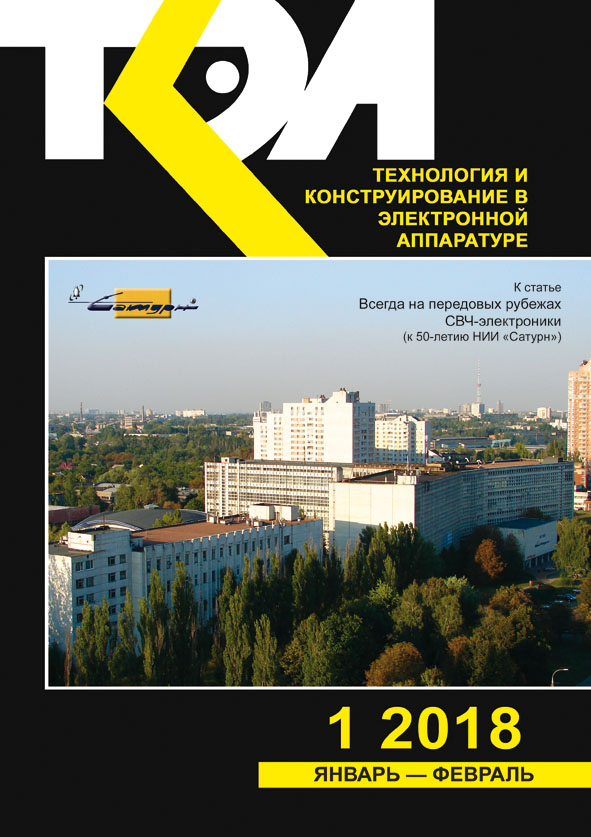Application of resettable elements for electrical protection of solar batteries
Abstract
The manifestation and formation of various defects in the process of exploitation in real photovoltaic cells and their compounds as well as their work in the regime of changing non-uniform illumination lead to the so-called series and parallel inconsistencies (differences of electrical characteristics) between separate cells and their groups. This results in local overheating and intensifying of degradation processes.
In some cases temporary disconnection (isolation) of the corresponding elements of the solar batteries is more appropriate in order to increase their service life.
In this work additional devices for insulation of overheating cells (and/or components) of solar batteries such as «PolySwith» resettable fuses are proposed to be used as a perspective solution of such problems. These structures are polymer composites with nanosized carbon fillers. Electrical resistance of such a fuse increases abruptly by several orders of magnitude when certain threshold temperature is reached, and when the temperature decreases the fuse returns to its initial high-conductivity state.
This study investigates the possibilities of using the specified type of fuses for electrical insulation of «overheated» photovoltaic cells. Particular attention is paid to the research of the effect of fuses on the working of the solar batteries in the operating temperature range and their functional applicability in emergency situations associated with overheating. The studies were carried out using a model structure of several series of parallel connected photovoltaic cells and specified fuses. Attention is paid to the influence of such factors as the ambient temperature and the drift of the fuses resistance in the conducting state in the process their multiple switching.
It has been established that such protection elements do not influence the work of solar batteries in operating temperature range and are functionally applicable for the electrical isolation of local regions and components of solar batteries with increased temperature.
References
Honsberg C., Bowden S. Welcome to PVCDROM [Electronic resource]. 2017, mode access: http://www.pveducation.org/pvcdrom
Silvestre S., Chouder A. Effects of shadowing on photovoltaic module performance. Progress in Photovoltaics: Research and Applications, 2008, vol. 16, nо. 2, рр. 141-149. https://doi.org/10.1002/pip.780
Tsanakas J. A., Botsaris P. N. An infrared thermographic approach as a hot-spot detection tool for photovoltaic modules using image histogram and line profile analysis. International Journal of Condition Monitoring, 2012, vol. 2, no. 1, pp. 22-30. https://doi.org/10.1784/204764212800028842
Silvestre S., Boronat A., Chouder A. Study of bypass diodes configuration on PV modules. Applied Energy, 2009, vol. 86, iss. 9, pp. 1632-1640. https://doi.org/10.1016/j. apenergy.2009.01.020
Ji Eun Lee, Soohyun Bae, Wonwook Oh, Hyomin Park, Soo Min Kim, Dongho Lee, Junggyu Nam, Chan Bin Mo, Dongseop Kim, JungYup Yang, Yoonmook Kang, Haeseok Lee, Donghwan Kim. Investigation of damage caused by partial shading of CuInxGa(1–x)Se2 photovoltaic modules with bypass diodes. Progress in Photovoltaics: Research and Applications, 2016, vol. 24, iss. 8, pp. 1035-1043. https://doi.org/10.1002/pip.2738
Karatepe E., Boztepe M., Colak M. Development of a suitable model for characterizing photovoltaic arrays with shaded solar cells. Solar Energy, 2007, vol. 81, iss. 8, pp. 977-992. https://doi.org/10.1016/j.solener.2006.12.001
Kurtz S., Whitfield K., TamizhMani G., Koehl M., Miller D, Joyce J., Wohlgemuth J., Bosco N., Kempe M., Zgonena T. Evaluation of high-temperature exposure of photovoltaic modules. Progress in Photovoltaics: Research and Applications, 2011, vol. 19, iss. 8, pp. 954-965. https://doi.org/10.1002/pip.1103
Zezin D. A. Dis. kand. tekhn. nauk [Degradation processes in thin-film solar cells]. Moskow, 2014, 129 p. (Rus)
Trusov V.A., Gusev A.M. [Elements of protection of electrical circuits against overvoltages and overcurrents]. Proc. of Int. Symp. “Reliability and Quality”, 2011, vol. 2. pp. 221-224 (Rus)
Gavrikov V. [Self-healing PTC fuses for protection of current overload ]. Novosti Elektroniki, 2014, no. 12, pp. 11-15. (Rus)
Kyung-Yong Cheon. Battery pack with battery protection circuit. Pat. USA no. 5963019, 1999.
J. W. Oglesbee, A. G. Burns. Overcharge protection device and methods for lithium based rechargeable batteries. Pat. USA, no. 6608470, 2003.
A. D. Minervini, T. K. Nguyen. Electrical devices having a polymer PTC array. Pat. USA, no. 6282072, 2001.
Protecting rechargeable Li-ion and Li-polymer batteries [Electronic resource]: Littelfuse, Inc., 2017, mode access: http://www.littelfuse.com/~/media/electronics/application_notes/littelfuse_protecting_rechargeable_li_ion_
and_li_polymer_batteries_in_consumer_portable_electronics_ application_note.pdf.pdf
E. C. Dimpault-Darcy, B. J. Bragg. Thermal switch disc for short circuit protection of batteries. Pat. USA, no. 4973936, 1990.
Kaminskayа T. P., Domkin K. I. [Self-healing fuses for automotive electronics]. Elektronnye komponenty, 2008, no. 5, pp. 80-82. (Rus)
Tonkoshkur O. S., Іgnatkіn V. U. Fіzichnі osnovi elektrichnogo kontrolyu neodnorіdnikh sistem [Physical bases of electrical control of inhomogeneous systems: educational textbook]. Dniprodzerzhynsk State Technical University, 2010, 290 p. (Ukr)
Khukhtikov S. [Restore working capacity! ». Selfhealing PPTC-fuses MultiFuse]. Novosti Elektroniki, 2015, no. 1, pp. 37-41. (Rus)
[Sel f -heal ing fuses [Elect ronic resource]: Terraelektronika], 2018, mode access: https://www. terraelectronica.ru/catalog/samovosstanavlivayuschiesyapredohraniteli-1522 (Rus)
Application note. Polyswitch strap devices. Help protect rechargeable battery packs [Electronic resource]. Tyco Electronics Corporation, 2008, mode access: https://www.digikey.com/Web%20Export/Supplier%20Content/Tyco_8004/PDF/TE_Strap_Device.pdf
Nakashidze L. V., Knysh L. I. [Methodology for determining the composition and circuit design of solar photovoltaic equipments]. Aviatsionno-kosmicheskayа tekhnika i tekhnologiyа, 2008, no. 10 (57), pp. 100-104. (Rus)
Koltun M. M. Optika i metrologiyа solnechnykh elementov [Optics and metrology of solar elements]. Moscow, Nauka, 1985, 280 p. (Rus)
Jim Toth. PolySwitch PPTC device principals of operation [Electronic resource], mode access: http://studyres.com/doc/7802565/polyswitch-pptc-device-principals-ofoperation?page=5
Belykh S. [New innovative self-healing protection component for power lithium-ion accumulators]. Components & Technologies, 2011, no. 2, pp. 50-53. (Rus)
Copyright (c) 2018 Tonkoshkur A. S., Ivanchenko A. V., Nakashydze L. V., Mazurik S. V.

This work is licensed under a Creative Commons Attribution 4.0 International License.

